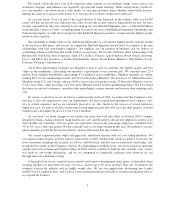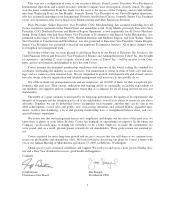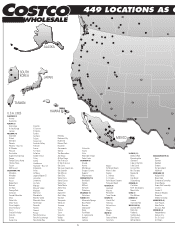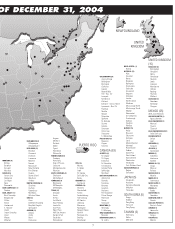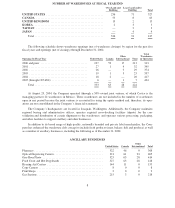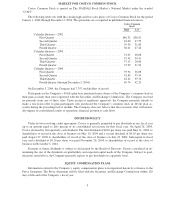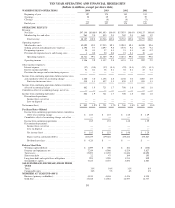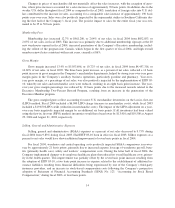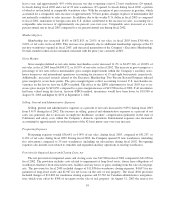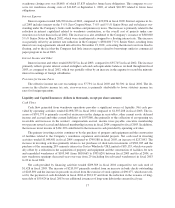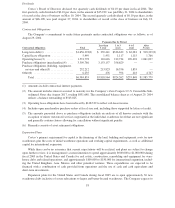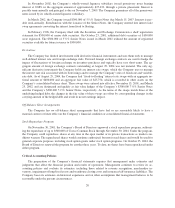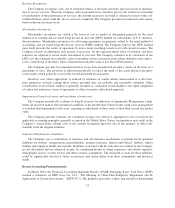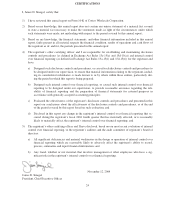Costco 2004 Annual Report Download - page 16
Download and view the complete annual report
Please find page 16 of the 2004 Costco annual report below. You can navigate through the pages in the report by either clicking on the pages listed below, or by using the keyword search tool below to find specific information within the annual report.Changes in prices of merchandise did not materially affect the sales increases, with the exception of gaso-
line, where price increases accounted for a sales increase of approximately 70 basis points. In addition, due to the
weaker U.S. dollar throughout fiscal 2004 as compared to fiscal 2003, translation of foreign sales into U.S. dol-
lars contributed to the increase in sales, accounting for a comparable sales increase of approximately 190 basis
points year-over-year. Sales were also positively impacted by the supermarket strikes in Southern California dur-
ing the first half of the Company’s fiscal year. The positive impact to sales for the entire fiscal year was esti-
mated to be 35 to 50 basis points.
Membership Fees
Membership fees increased 12.7% to $961,280, or 2.04% of net sales, in fiscal 2004 from $852,853, or
2.05% of net sales, in fiscal 2003. This increase was primarily due to additional membership sign-ups at the 20
new warehouses opened in fiscal 2004; increased penetration of the Company’s Executive membership, includ-
ing the rollout of the program into Canada, which began in the first quarter of fiscal 2004; and high overall
member renewal rates consistent with recent years, currently at 86%.
Gross Margin
Gross margin increased 13.4% to $5,053,696, or 10.72% of net sales, in fiscal 2004 from $4,457,316, or
10.69% of net sales, in fiscal 2003. The three basis point increase, as a percent of net sales, reflected a 14 basis
point increase in gross margin in the Company’s merchandise departments, helped by strong year-over-year gross
margin gains in the Company’s ancillary business operations, particularly gasoline and pharmacy. Year-over-
year gross margin, as a percentage of net sales, was also positively impacted by the implementation of EITF 03-
10, whereby net sales and merchandise costs were reduced, resulting in an eight basis point increase. The year-
over-year gross margin percentage was reduced by 12 basis points due to the increased rewards related to the
Executive Membership Two-Percent Reward Program, resulting from an increase in the penetration of the
Executive Member program.
The gross margin figures reflect accounting for most U.S. merchandise inventories on the last-in, first-out
(LIFO) method. Fiscal 2004 included a $6,090 LIFO charge (increase in merchandise costs), while fiscal 2003
included a $19,650 LIFO credit (reduction in merchandise costs). The impact of the LIFO adjustment on a year-
over-year basis negatively impacted margin by an additional six basis points. If all inventories had been valued
using the first-in, first-out (FIFO) method, inventories would have been lower by $13,410 and $19,500 at August
29, 2004 and August 31, 2003, respectively.
Selling, General and Administrative Expenses
Selling, general and administrative (SG&A) expenses as a percent of net sales decreased to 9.75% during
fiscal 2004 from 9.83% during fiscal 2003. Had EITF 03-10 been in effect in fiscal 2003, SG&A expenses as a
percent to net sales would have shown additional improvement of seven basis points in fiscal 2004.
For fiscal 2004, warehouse and central operating costs positively impacted SG&A comparisons year-over-
year by approximately 21 basis points, primarily due to increased expense leverage of warehouse payroll, bene-
fits (primarily health care), utility and workers’ compensation costs. During the latter half of fiscal 2004, the
Company implemented changes to its employee healthcare plans that reduced its overall healthcare costs, primar-
ily in the fourth quarter. This improvement was partially offset by the seven basis point increase resulting from
the adoption of EITF 03-10, a two basis point increase in expense related to the establishment of additional in-
surance liabilities resulting from financial difficulties being experienced by one of the Company’s third-party
insurance providers, and an increase in stock-based compensation costs following the Company’s prospective
adoption of Statement of Financial Accounting Standards (SFAS) No. 123, “Accounting for Stock Based
Compensation,” during fiscal 2003, of four basis points.
14


